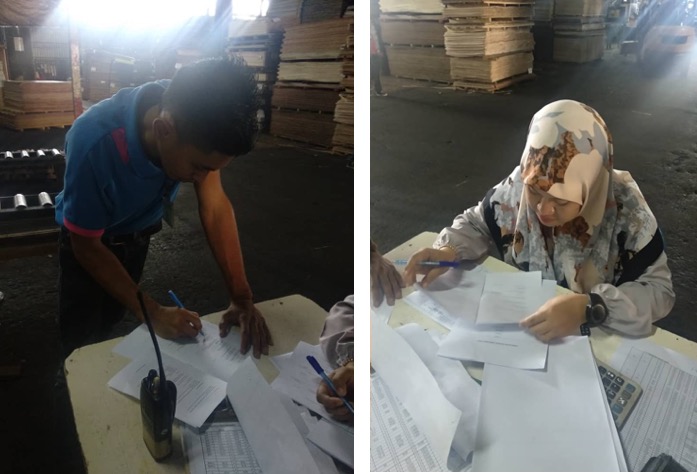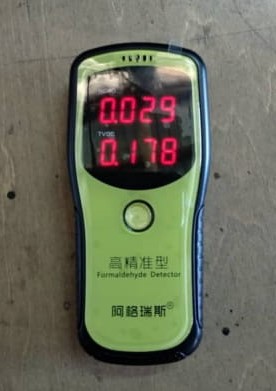Effect of formaldehyde emission in health conditions plywood industry workers
1.0 Introduction
Safety and health is the biggest concern among workers in wooden industry workers. This is a genuine issue when most of the workers in the wood industry all over the world don't fulfill the base guidelines and rules set by global organizations (Ooi, 2008). In the woodworking industry, the workers will expose with a different kind of hazard and health problem especially when working with chemical solvents, when get involve with machinery, working with dust and light and when involving with noise and other internal and external factors.
The main focus of the study is to elaborate more on the safety and health when involving with the chemical solvents such as synthetic resin that commonly use in the wood industry. Most of this synthetic resin been used in the wood industry as materials, including plywood, oriented strand-board, particleboard, fiberboard, structural composite lumber, doors, windows and frames, and factory-laminated wood products. The synthetic resin that commonly used contain formaldehyde. Formaldehyde is usually released during hot pressing, coating and furnished furniture. Based previous study by Istek et al. (2018), formaldehyde emission can present some risk to human health. The objectives of this research is to explore which process/area in wood processing have high emission of formaldehyde.
The main focus of the study is to elaborate more on the safety and health when involving with the chemical solvents such as synthetic resin that commonly use in the wood industry. Most of this synthetic resin been used in the wood industry as materials, including plywood, oriented strand-board, particleboard, fiberboard, structural composite lumber, doors, windows and frames, and factory-laminated wood products. The synthetic resin that commonly used contain formaldehyde. Formaldehyde is usually released during hot pressing, coating and furnished furniture. Based previous study by Istek et al. (2018), formaldehyde emission can present some risk to human health. The objectives of this research is to explore which process/area in wood processing have high emission of formaldehyde.
2.0 Experimental Design
The reading of the formaldehyde emission was observed and compared between the 3 different sections in wood processing such as glue spreader, hot press, and dryer section in a plywood industry in Tawau, Sabah. The primary method applied to determine a formaldehyde emission reading is by using a professional air tester. The formaldehyde emission was measured at the selected section (glue spreader, hot presser and dryer section) 3 times (morning, noon and evening) from 7:00 a.m. to 4:00 p.m. Measurements were conducted with three replications at each section.
3.0 Result and Discussion
3.1 Reading of Formaldehyde Emission (HCHO) and Total Volatile Organic Compound (TVOC).
Normally in both outdoor and indoor air, the levels of formaldehyde gas are usually less than 0.03 parts per million (ppm) which is present at a low level. But, the levels of formaldehyde could be greater than 0.03 ppm that release from the residences or offices/factories that contain products that release formaldehyde into the air. Table 1 shows the product is aligned with its emission standard in parts per million (ppm)

4.0. Data Analysis
The information and data gathered was analysed using Statistical Package for Social Science (SPSS). According to Table 2, the result is not significant because: p-value > 0.05. Thus, there is no association between the variable groups of formaldehyde emission (HCHO) with the three area of the factory, i.e., glue spreader, hot press, and dryer section, and the same result for TVOC. There is the significant correlation between HCHO and TVOC.

5.0 Discussion
From the previous research, the effect of the high exposure of formaldehyde emission at a certain place without proper ventilation and prevention may lead to various diseases including tumours, and lead to cancer. For the data that has been taken in the plywood factory (questionnaire), the factory has been used LFE (Low Formaldehyde-Emission) resin as a binder for the plywood. Based on the observation, it was found that 6.7 % respondents suffered from headaches and most respondents answered that it occurred occasionally. Apart from that13.3% of respondents suffered from watery eyes and nose, and 10% of the respondents faced skin problems and allergic. These might be due to low exposure of formaldehyde emission and low in formaldehyde content in the LFE (Low formaldehyde –Emission) resin. As recommendation, precaution step should be taken by the workers of the plywood industry to wear proper personal protective equipment, to use an alternative adhesive (phenol formaldehyde, isocyanate) to urea formaldehyde adhesives, to have a proper ventilation in the factory and installing chimney to take away the harmful smoke and gases produced in the factories to reduce its harmful effects on the ground.
6.0 Conclusion
The diseases due to formaldehyde emission, were headaches, watery eyes and nose and skin problems and allergic. The ANOVA result on the level of HCHO (formaldehyde emission) and TVOC (Total volatile organic compound), shows that the HCHO (formaldehyde emission) and TVOC (Total volatile organic compound) have no significant different between three areas of the factory. However, there was a relationship between HCHO and TVOC at the plywood factory.

Worker filling questionnaire

Professional air tester

